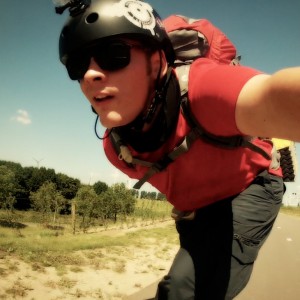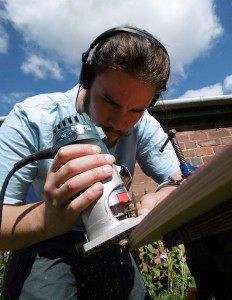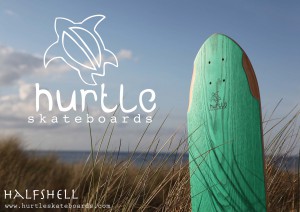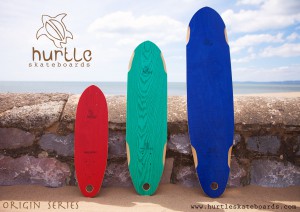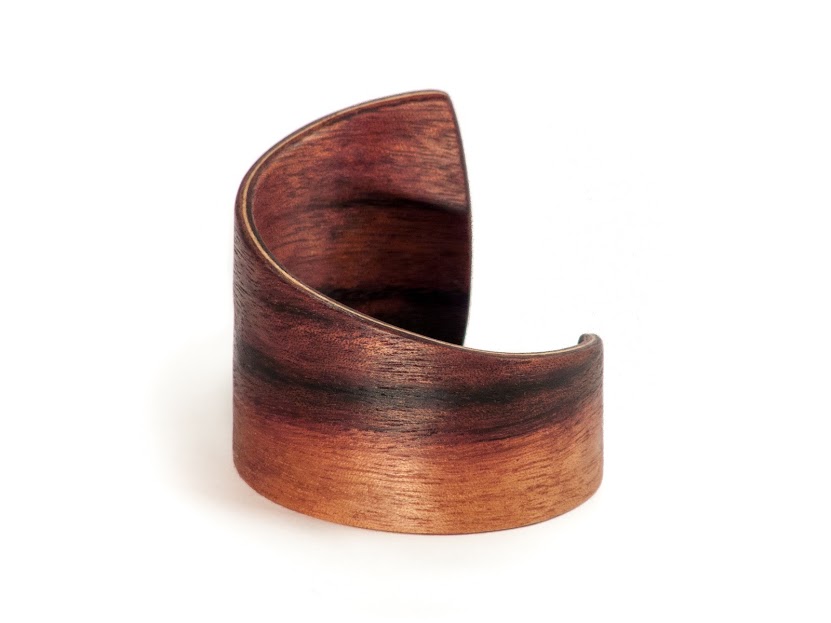
by Valentin Sébart | Mar 2, 2016 | News/events
Several months ago, Roarockit received an order from Wood’n’Stuff. Ever since, we have been in admiration of his work, following his technics and the evolution of his projects.
Now, months down the road, we are particularly proud to be able to share the story behind Wood’n’Stuff and what it has become today.
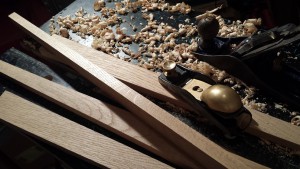 So, can you tell us a little bit about yourself, where do you come from, what you did before etc…?
So, can you tell us a little bit about yourself, where do you come from, what you did before etc…?
Sure — I’m Peter, a thirty something occasional woodworker from the town of Budapest, Hungary and a proud father of two. I manage a software product by day and I have a second life working with wood by night. I guess it’s needless to draw your attention to the classic “concealed superhero” setting here 😛
When did you first get into woodworking ?
It started out with a hinge that I wanted to mortise into an IKEA storage bench. I carefully researched the subject — that’s two YouTube videos — then headed out to the home improvement store and returned with a chisel and a mallet. Four gruelling hours later I swiped away the sweat on my forehead and proudly adored two rather ugly-looking recesses for the hinges. With the 10 points immediately deposited on my Manliness Account, I decided this experience was for me and that’s where it all started (only later I learned that chisels are sold dull and need to be sharpened before first use).
This was two years ago. Ever since then I stick with hand tools — chisels, hand saws and hand planes, that kind of stuff. They are slow and take a good deal of skill that I’m still very much in progress of acquiring, but they offer a kind of intimacy with wood I doubt I could get from power tools. It’s an incredibly intensive thing. And I get to keep my fingers.
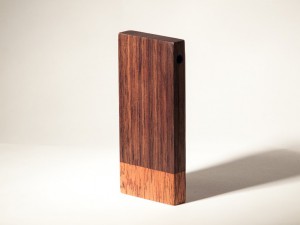
When, why and how did you find the Roarockit technology ?
Frankly, I don’t recall where exactly I ran into it, but I do remember it was some Internet forum where the commenters said the inventor’s idea can’t possibly work. This was kind of odd for a product that has already been proven and sold by then, so the name “Roarockit” stuck in my mind.
A year later, when my project ideas called for something more flexible than traditional clamping I decided to give the TAP kit a try. In a way, this was because someone, somewhere once said that this was going to be a poor decision 🙂 You gotta love the irony.

In particular, I looked into vacuum pressing because my bentwood bracelets are made of several layers of veneers laminated onto circular molds and vacuuming saves me tons of work by not having to make a mold negative to press veneers onto the mold.
I have to admit I had doubts about whether TAP will work for the tighter curves I need compared to a skateboard, but once the test project passed with flying colors — no gaps between layers or impressions from the breathing net — I put it into use immediately. My setup is pretty similar to the skateboard building one, except that I use thinner veneers (1/32” instead of 1/16”) and another PVA glue instead of Titebond III. I’m yet to test it with some of the more rigid veneers like goncalo alves, but I’m confident it will work just as
flawlessly as with the softer hardwoods.
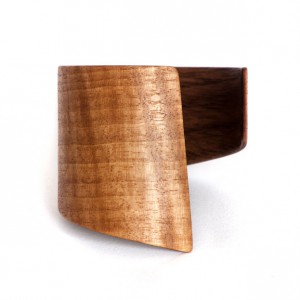 What is the spirit of wood’n’stuff? Why did you create it ?
What is the spirit of wood’n’stuff? Why did you create it ?
How could I not? It combines my two things I feel passionate about: woodworking and creating products 🙂 It’s so much fun to build something from the ground up, starting with nothing but blank canvas.
The spirit is definitely geometric as opposed to ornamental. Ok, it positively helps that I suck at drawing, but being a “sans serif” kind of guy, the things that get me going are lines, angles, ratios, curves borrowed from perfect circles. Frankly, I could admire a perfectly polished slab of steel for hours 🙂 Geometry is also such an alien concept to an utterly organic material like wood that it acts as a frame and highlights the natural grain of wood. A hard edge on a block of wood forces your mind to traverse the grain, to reveal the structure, to fully comprehend the uniqueness of wood as a material.
What do you expect from wood’n’stuff? How far do you want to go ? 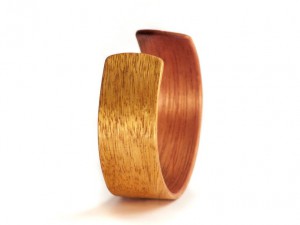
Wherever the road takes us! At this point, I’m thinking about growing a well-groomed beard and buying a flannel shirt to get fully immersed in the subculture 🙂
I try to keep this project fun and not to take it too seriously — hence the name “wood’n’stuff” — which is surprisingly hard given the tremendous passion that goes into it. Of course, in my dreams it grows into an awesome full-time woodworking enterprise, with a rustic barn converted into a heated shop and huge slabs of walnut neatly stacked up next to my collection of $400 Lie-Nielsen bench planes, but let’s just say the seed has just sprouted and there’s a long way ahead and milestones to conquered. Like reaching breakeven. Ahem 🙂
Are there any new projects for wood’n’stuff?
Oh, more than I have time for. I definitely want to further explore veneer lamination bracelets and I can freely experiment with any convex shape now, thanks to my TAP kit which I hereby endorse 🙂 I have some exciting ideas that will be put to the test in the coming weeks.
I’m also very interested bringing cast concrete and wood together. Walnut with its earthy brown, in particular, looks stunning next to grey industrial concrete, so that should be another way to bring out the beauty of wood.
Find Peter and his Etsy shop at https://woodplusstuff.etsy.com
and on Instagram at @wood.n.stuff (https://www.instagram.com/wood.n.stuff/)
.
.
Facebook page : RoarockitSkateboardEurope
Profile : Roarockit Europe
Website : Roarockit.eu
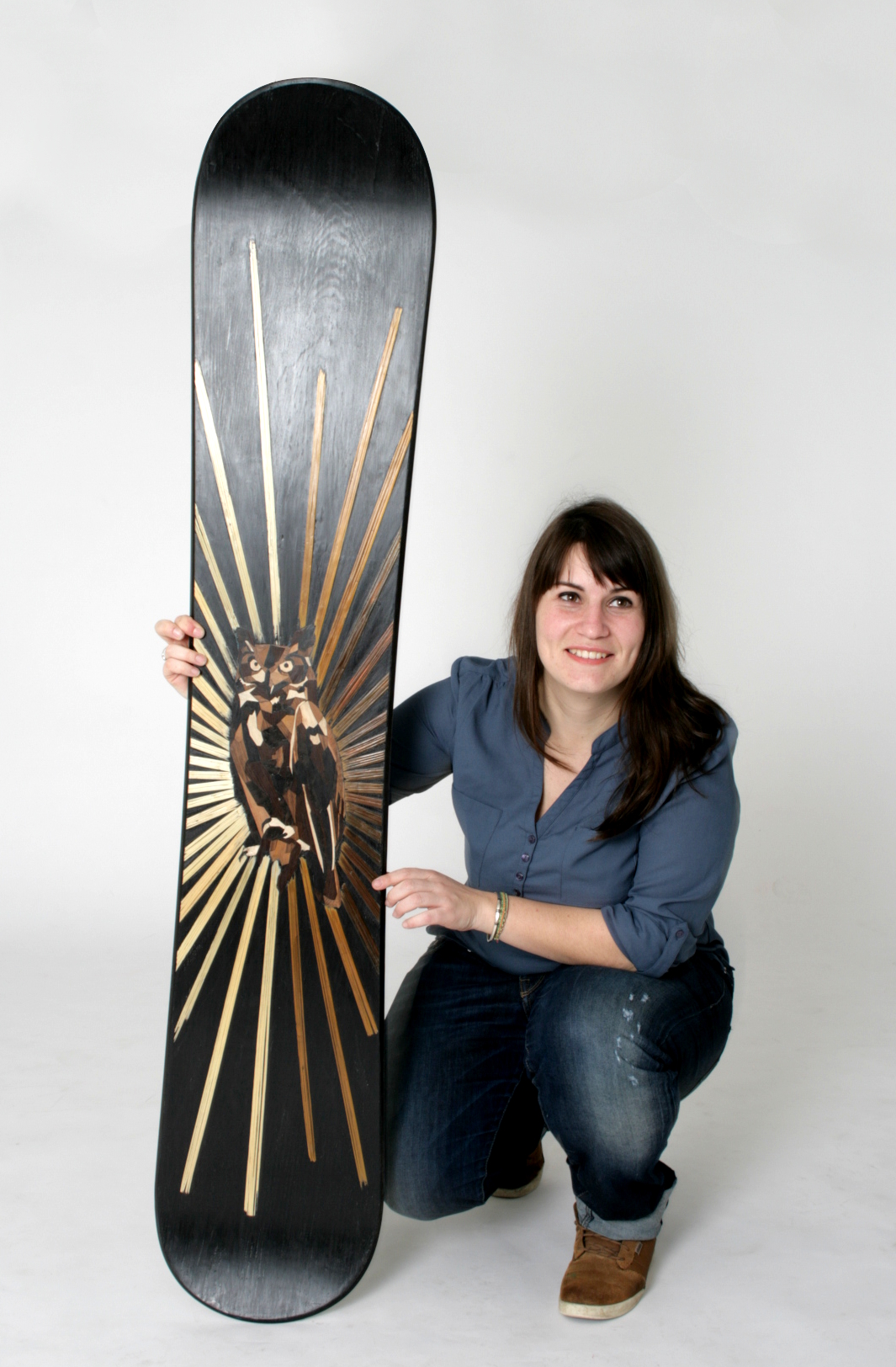
by Valentin Sébart | Feb 23, 2016 | News/events
Cela fait déjà un petit moment que l’on connait et que l’on suit avec attention le travail d’Audrey. C’est donc fièrement que l’on vous propose de la découvrir à travers cet interview honnête et sans complexe :
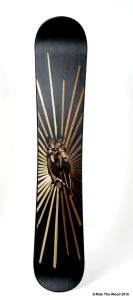
SnowBoard Marquetry Owl
1. Salut Audrey, peux tu te présenter ? Quel âge as tu (pas obligatoire bien sur ;)), d’où viens tu, ton boulot, ton parcours…
Salut! Et bien, j’ai 27 ans et je viens de Toulouse. Avec six ans de formations aux métiers du bois (CAPs et Diplôme des Métiers d’Art) entre le Lycée de l’Ameublement de Revel (31), le Lycée des Métiers d’Art d’Uzes (30) et un passage éclair à l’Ecole Boulle à Paris, j’ai travaillé quelques mois en finition chez un fabricant d’intérieurs de jets privés puis chez un fabricants de skis. Après avoir déménagé de nombreuses fois, j’ai posé mes valises dans le bassin Valentinois il y a plus d’un an, ainsi, depuis le mois d’octobre 2015, j’exerce la marqueterie à mon compte, en parallèle d’un emploi d’animatrice pour enfants
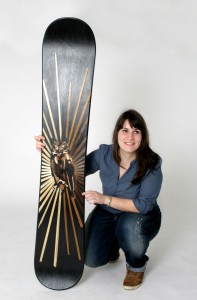
Audrey FASQUELLE – RideTheWood
2. Qu’est ce qui t’as amené à travailler le bois ?
Depuis toute petite, je bricole. J’ai la chance d’avoir des parents qui savent faire beaucoup de choses par eux même et qui ont su partager leur savoir faire avec leurs enfants. Lorsque je passais mon bac, on m’a parlé de l’ébénisterie. Je suis donc allée me renseigner au lycée pro de Revel et ça a été un coup de cœur! Depuis ma formation, dès que j’ai l’opportunité de faire un atelier bois avec les enfants sur les centres de loisirs, je n’hésite pas, espérant réveiller une vocation chez quelques uns d’entre eux.
3. Tu as fait le choix d’utiliser notre matériel à savoir, la Thin Air Press. Pourquoi ce choix ?
C’est après avoir cherché «fabricants de skate» sur Internet que je suis tombée sur le site Roarockit. En fouinant sur la page Web, j’ai trouvé les presses sous vide, j’ai alors pris la décision d’acheter le grand modèle, qui s’adapte très bien pour mes snowboards. Le prix est attrayant aussi. Un coup d’aspirateur, la pompe manuelle, et le tour est joué! Je ne regrette pas du tout cet investissement.
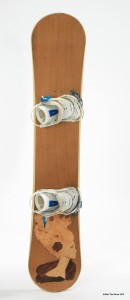
SnowBoard Marquetry Who Board
4. On a vu que tu avais créé RideTheWood. Racontes nous cette histoire ? Le début, les galères, les joies…
J’ai commencé à penser à Ride The Wood courant 2014. Lorsqu’on passe un Diplôme des Métiers d’Art, on nous apprend à sortir des sentiers battus, à innover. J’ai fait le rapprochement entre ma formation et une passion, et j’ai fait un test sur un snow (Who Board). Les retours positifs m’ont poussée à persévérer. Tout en continuant les prototypes pour les snow, j’en ai profité pour essayer des supports éclectiques (guitares, skates, radio vintage… Etc) Ride The Wood, ce n’est pas que du snow, c’est aussi d’autres supports tout aussi funs. Les joies que j’éprouve? Découvrir le produit fini après toutes les étapes de réalisation. Les galères, se soucier de trouver les bonnes techniques innovantes et bien sûr la partie administrative.
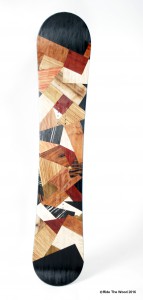
SnowBoard Marquetry Wood Multi Essence.
5. Quand on regarde ton travail sur les snowboards, on devine que tu as passé un temps fou à leur conception. Peux-tu nous expliquer le travail que tu as fait?
Il y a d’abord la recherche de motifs. Sur les dernières planches, j’ai eu la chance d’avoir les dessins du graphiste GunndBoy. Il faut faire ce que l’on appelle un calque, qui servira à faire la mise en couleur, la légende, les ombrages si nécessaire… ensuite, découper chaque pièce sur papier pour les coller sur les feuilles de bois, puis de nouveau, découper les placages. En fonction du nombre de pièces, la découpe et l’assemblage peuvent prendre plus ou moins de temps (Pour le hibou, il y a pas loin de 150 pièces et une quinzaine d’heures de travail). Je déplaque ensuite le snow que je souhaite personnaliser et j’y colle la marqueterie avec la presse sous vide. Reste la finition qui prend pas mal de temps.
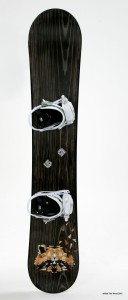
SnowBoard Marquetry Racoon
6. Comment vois-tu l’avenir de RideTheWood ? Des nouveaux modèles, quelques projets?
Je souhaite pouvoir travailler avec des artisans de la glisse, tout comme avec des particuliers. Je voudrais aussi développer les différents styles de graphisme, et enfin, tester de nouveaux matériaux, ou confirmer l’utilisation de la paille sur snowboard qui n’a encore jamais été utilisée d’après mes recherches.
7. Le mot de la fin. Des remerciements ou des dédicaces ?
Je pense que oui, il y a pas mal de monde que je dois remercier, ma famille tout d’abord, qui m’a permis de découvrir l’artisanat du bois et mes professeurs qui me soutiennent toujours après toutes ces années. Je tiens aussi à remercier toutes les personnes qui me donnent une chance de faire ma place sur des événements et de faire connaître mon travail et enfin, l’atelier Phénix, mon premier partenariat fabricant/marqueteur.
On vous invite à jeter un coup d’œil, sur sa page facebook : RideTheWood
Page facebook : RoarockitSkateboardEurope
Profil : Roarockit Europe
Page internet : Roarockit.eu
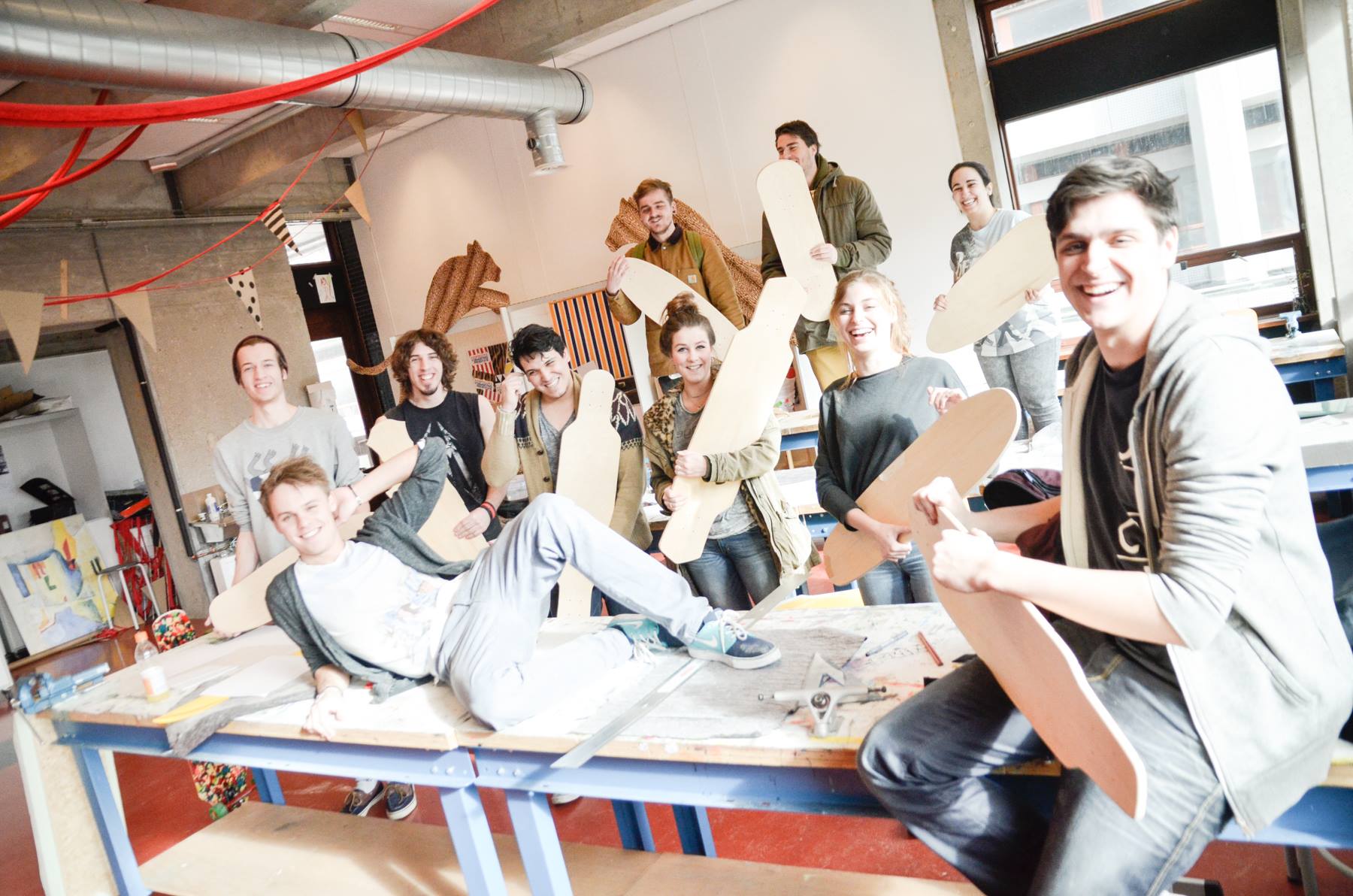
by Sarah Roarockit | Mar 26, 2015 | News/events
A few months ago, Martijn Janssen contacted us with the intention of starting up a 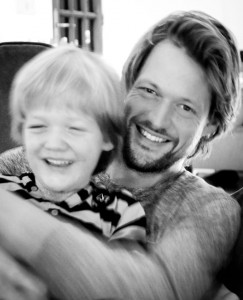 “Build Your Own Skateboard” workshop at the Grafisch Lyceum in Rotterdam, Holland. We were more than happy to get him sorted with what was needed and only a little while later we were over the moon, when the first photos of the boards being built in class and then the finished decks were put up on facebook. The result is amazing.
“Build Your Own Skateboard” workshop at the Grafisch Lyceum in Rotterdam, Holland. We were more than happy to get him sorted with what was needed and only a little while later we were over the moon, when the first photos of the boards being built in class and then the finished decks were put up on facebook. The result is amazing.
This being one of the first schools in Europe to have started up the program, after many years of successful workshops in Canada and the States, we asked if we could do an article to put forward the amazing work that has been put into this project and to find out how it went.
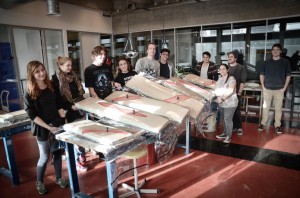
My name is Martijn Janssen and I am currently teaching Media Design at Grafisch Lyceum Rotterdam. Before I started teaching I ran my own company in interactive media design and animation. I was also one of the founders of eyesupply.tv, a VJ collective now responsible for the visual shows of Armin van Buuren and Afrojack, among others. I stopped VJ-ing when my son Kik was born and I could not combine the work at school, late night shifts in the weekends and being a dad.
Ever since I could hold a hammer and some basic tools I made a lot of my own toys. And I never really stopped “Making Stuff”. In the 90’s I studied Industrial Design. In the year 2000 I decided to built a snowboard with a friend, a one of project. A lot of different smaller and bigger projects followed and than in 2013 I wanted to build a hollow wood surfboard. I searched a lot on the internet and at one point I came across someone, a surfboard builder, who had built a skateboard just for fun. This seemed much less complex than building a surfboard and I decided to give it a go. And I’m hooked, it also got me picking up skateboarding again (after almost 20 years!).
I hadn’t worked with the Roarockit materials before, but was very interested in them. And once the plan for organising the workshop at my school found approval, I knew this system would work best to get the students to understand the process of building your own board.
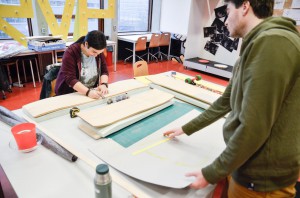
The first board was a “mini” longboard for my son. The result was far better than I expected and in no time I made one for myself. The third board I did (“La Troisième”) was noticed by a friend of mine who asked me to build some more of “these gorgeous boards” and sell them at the Indie Kids Festival, a fair of independent brands in Amsterdam. I had one month to create the brand and about 15 (mini) skateboards. I teamed up with Henk de Bruin, fellow teacher and illustrator to make the first Superkik series.
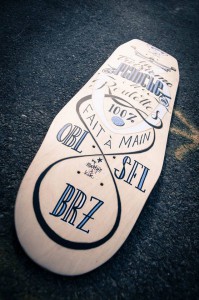
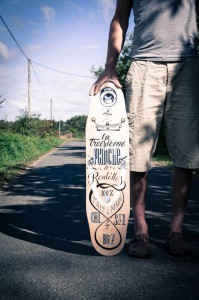
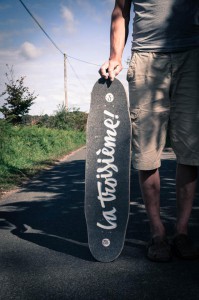
This was a succes, we sold 5 boards and received quite some custom orders in the months after that.
I decided to name the brand Superkik because I registered superkik.nl in the past. My son Kik is a big super hero fan.
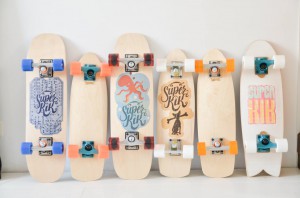
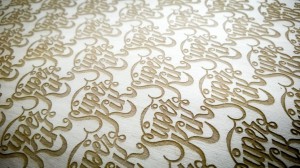
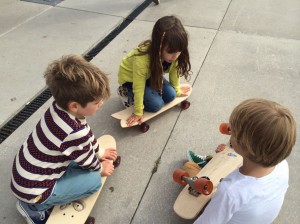
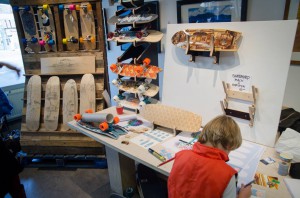
The boards had drawn the attention of students and colleagues and I started a few other collaborations. Some were even interested in designing and building their own boards. Than the opportunity came with the annual workshop week for our graduation students. Students can follow workshops and seminars of choice to gain some extra knowledge and skills in a fun way. So I submitted the idea of teaching 10 students to build their own board.
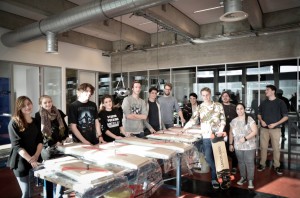
I told my bosses that the students were about to build the ultimate canvas for their artwork: A skateboard they could actually ride! Since skateboarding is closely related to the creative industry, it was not hard to convince them to invest in the materials and tools for this workshop.
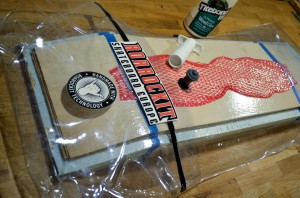
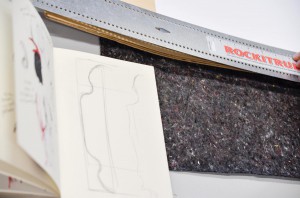
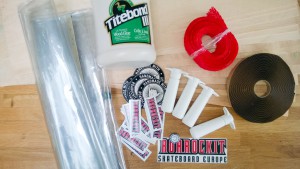
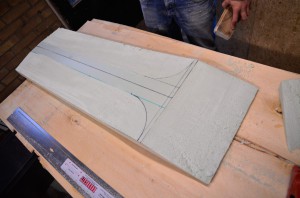
Together with Niels de Bruin from Langplanck we put a program together. We did a short introduction of what to expect and started with shaping of the moulds. We helped out with the design and the students shaped the foam completely by hand. By the end of the morning we had to glue the boards together and put them in the presses. Than two weeks passed before we could get to part two of the workshop: designing and cutting the outline, finish the rails, top and bottom and drilling the holes. The finishing had to be done by hand again.
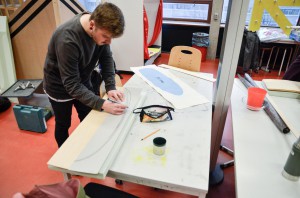
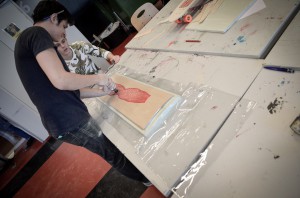
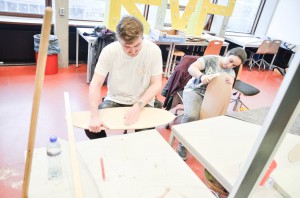
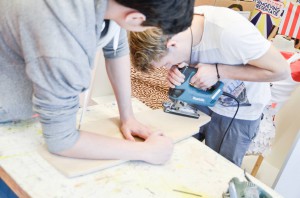
This concluded the official workshop, we only had 2 x 4 hours. In the unofficial part 3 of the workshop we will help some of the students with applying their design to the board.
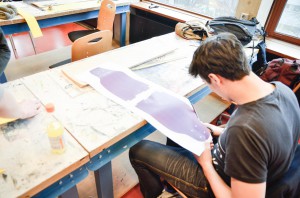
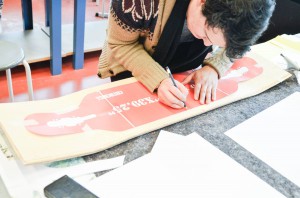
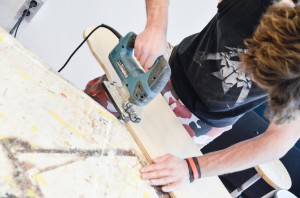
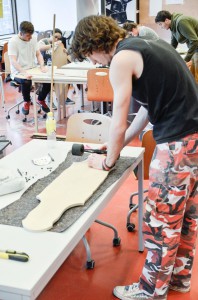
Over all we can conclude that next time we need more time. We could have spent some more time on the design part. Also an extra session to finish the board with a design and coating is necessary.
Nevertheless the workshop was one big succes and there was a real buzz in the school. A lot of students asked where they could sign up for the next edition. I even had a prospective student asking me: “In what department do they teach you how to build a skateboard?”
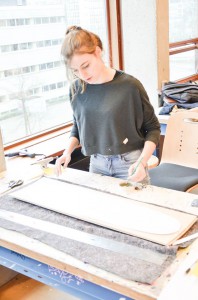
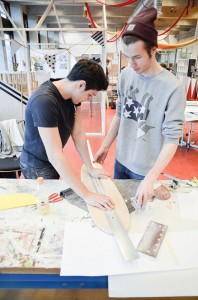
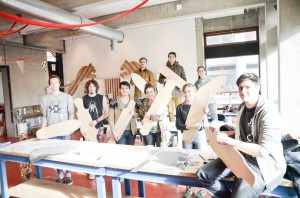

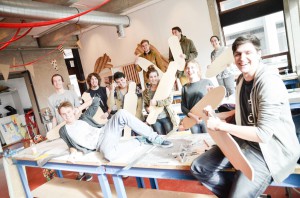
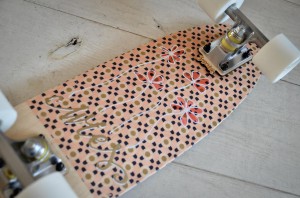
The next workshop will be with colleagues, we will keep you posted on the results!
We are looking into possibilities to run the workshop at other schools and are finetuning the program at the moment. Working with the maple and the TAP-bags was a breeze. I expect to do a lot more with both! The maple is very easy to work with and the results in quality and expression are simply amazing!
I’m more or less teaming up with Niels from Langplack to develop some longboards and we are going to experiment with other materials like bamboo, birch and carbon. Besides that I’m also working on new designs and techniques for the artwork. And finally, in the next few weeks we expect to shoot some footage for a promo for Superkik and Langplanck (in 4k!!).
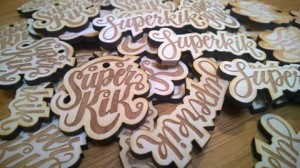
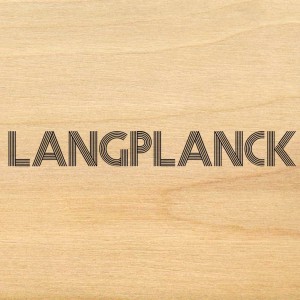
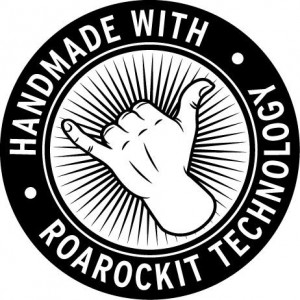
Roarockit Skateboard Europe
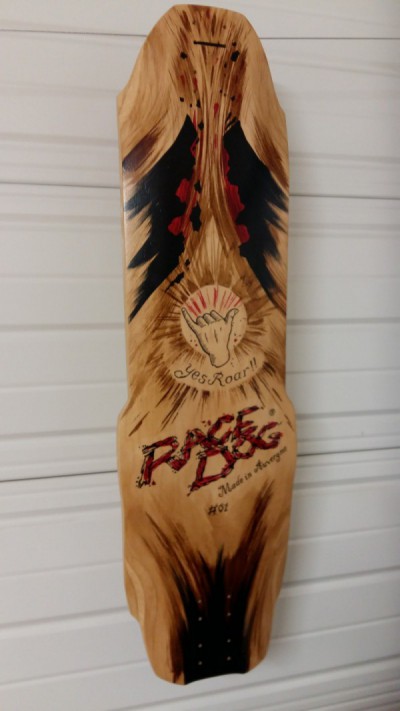
by Sarah Roarockit | Jan 27, 2015 | News/events

Voilà maintenant un an que nous avons rencontré Phil pour la première fois. En plus d’être très sympathique, il a indéniablement un véritable talent pour le shape. Il nous raconte ici son parcours et ses futures projets!…
1- Salut Phil, tu peux te présenter ? Tu as quel âge, tu viens d’où, quel est ton boulot…
– Salut Nico et Sarah, je m’appelle Phil Dupuis, je viens de fêter mes 48 balais, je viens de pas mal d’endroits en fait ! La
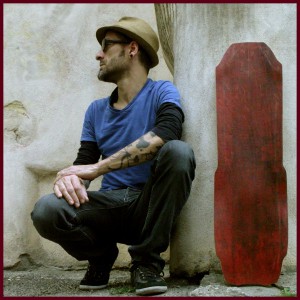
Phil Dupuis
construction de soi ça forme des couches (parfois une sacrée!), un peu comme les plis d’érable. J’ai fait des études de langues appliquées puis je me suis tourné vers des métiers à vocation créative, ce qui me ressemblait depuis toujours. J’ai été photographe de pub pendant une décennie puis je suis devenu tatoueur pro il y a douze ans, j’ai exercé dans plusieurs grandes villes, la dernière étant Clermont-Ferrand où je me suis installé il y a deux ans.
2- Qu’est ce qui t’as amené au shape?
– Ma première approche du shape remonte à longtemps, dans le domaine du windsurf où les premiers customs étaient construits à la main, comme les surfs, en shapant des pains de mousse haute densité pour les stratifier ensuite à la fibre de verre ou carbone/époxy, sans oublier le stade de la déco bien sûr. Ma première planche à voile shapée ainsi date de 1983 ou 84, ça fait trente ans. En 88-89, j’ai un peu bossé en surf-shop, bricolé sur les premiers snow alors que la discipline déboulait en Europe. Les engins n’étaient pas dérivés de la technologie ski à l’époque, ils étaient en foam-core et j’en ai ridé qui n’avaient même pas de carres !! Je les reprenais et je leur rajoutais des carres flexibles stratifiées à l’époxy. Quand au travail du bois, sur de petits objets, ça remonte à l’enfance. Comme beaucoup, j’ai mis gamin les pieds sur un skate, mais à l’époque (1977-78) je préférais déjà descendre des rues en pente que tenter des figures avec. Je me suis remis à rouler avec le longboard peu après mon arrivée à Clermont, et comme je voulais prendre un peu mes distances par rapport au tattoo et travailler le bois, j’ai choisi de fabriquer les boards sur lesquelles j’allais rouler.
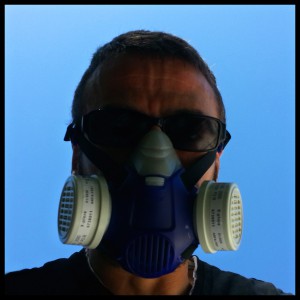
3- Tu as fait le choix d’utiliser notre matériel à savoir, la Thin Air Press et notre érable Canadien. Pourquoi ce choix?
– Comme je l’ai dit, j’ai de solides notions du travail du bois et de la matière, notamment grâce à mon père qui m’a appris pas mal de choses sur la résistance des matériaux, ce qu’était un effort mécanique, des trucs comme ça. Lui était ingénieur et a fait carrière dans l’industrie aéronautique, avec des parenthèses dans l’automobile de course dans les années 50. Tout en même temps, mon souhait de départ était de produire de manière artisanale. Il me fallait un matériel me permettant de pousser mes recherches assez loin dans les formes, sans pour autant investir l’intégralité de mon temps ou des budgets fous pour avancer. Je ne suis pas adepte des planches sans formes, bien sûr les riders de haut niveau font des merveilles quelque soit l’engin, mais si le shape n’avait pas son importance alors les surfers surferaient des planches à repasser, tout comme les snowboarders, les SUPers etc. Pour moi, le shape est une manière d’assurer la cohérance de l’engin avec sa pratique, son gabarit, son niveau. Il est au service du rider, et si tu peux rouler un longboard qui te permet de trouver et doser naturellement tes appuis, c’est gagné.
4- Tu as donc créé BadBigBoys Custom Longboards. Raconte-nous comment cela a commencé.
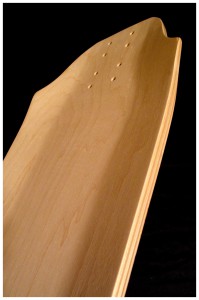 – La première planche que j’ai sortie, je l’ai offerte à mon fils ainé, qui avait 10 ans alors (mais je la roule également de temps en temps avec un set-up orienté freeride). Puis je me suis pris au jeu, tout en même temps que je progressais un peu dans ma façon de rouler, et que je m’orientais vers le DH. J’ai shapé un deuxième moule qui était censé donner une planche de descente. Le shape était timide, je n’avais pas osé pousser le bois dans ses retranchements et le calage des pieds était vraiment trop light. Je suis reparti avec l’idée de concevoir une board qui me guide tout autant que je la guiderais, et c’est comme ça qu’est née la RaceDog. C’est une board de descente, et non de freeride, elle est faite pour rester au sol, et d’ailleurs elle s’y accroche bien ! En quelques sessions avec, j’ai gagné en confiance et en vitesse, même si je veille à rouler très prudemment. Le contact avec les riders et l’accueil de la board ont fait le reste, je me suis lancé dans la production d’une mini série, le kiff étant de produire pour le plaisir et celui des autres. Pas de vocation mercantile, juste une cohérence entre le but et le travail mis en œuvre.
– La première planche que j’ai sortie, je l’ai offerte à mon fils ainé, qui avait 10 ans alors (mais je la roule également de temps en temps avec un set-up orienté freeride). Puis je me suis pris au jeu, tout en même temps que je progressais un peu dans ma façon de rouler, et que je m’orientais vers le DH. J’ai shapé un deuxième moule qui était censé donner une planche de descente. Le shape était timide, je n’avais pas osé pousser le bois dans ses retranchements et le calage des pieds était vraiment trop light. Je suis reparti avec l’idée de concevoir une board qui me guide tout autant que je la guiderais, et c’est comme ça qu’est née la RaceDog. C’est une board de descente, et non de freeride, elle est faite pour rester au sol, et d’ailleurs elle s’y accroche bien ! En quelques sessions avec, j’ai gagné en confiance et en vitesse, même si je veille à rouler très prudemment. Le contact avec les riders et l’accueil de la board ont fait le reste, je me suis lancé dans la production d’une mini série, le kiff étant de produire pour le plaisir et celui des autres. Pas de vocation mercantile, juste une cohérence entre le but et le travail mis en œuvre.
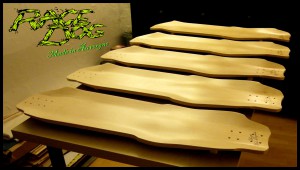
Ready-to-go
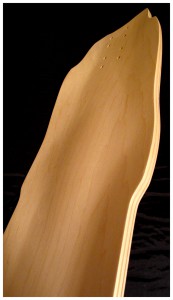
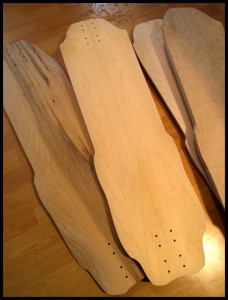
5- Quand on voit le shape de la Racedog on comprend tout de suite que tu as dû passer beaucoup de temps à l’élaboration de ton moule. Explique-nous un peu le travail réalisé sur cette planche.
– Pour la RaceDog, j’ai passé un temps fou à regarder mon pain de mousse le crayon à la main, avant de poser le 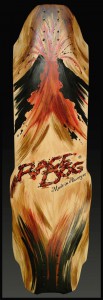 moindre repère de découpe ! J’avais dessiné un template (gabarit) pour le contour, évolution de la précédente planche, puis j’ai pris mon temps pour visualiser dans ma tête les zones d’appui, de poussée, d’équilibre, tout en mettant les pieds sur tous les decks que j’ai à la maison et en analysant ce qui me paraissait pertinent , qu’ils soient orientés carving, slalom ou freeride. Je suis parti rouler, je suis rentré, j’ai pris des notes, fait des croquis, reparti rouler et ainsi de suite. J’ai shapé mon moule en tenant compte de l’importance de chaque facteur et mis sous presse par demie-tranche, d’abord les 4 premiers plis, puis dans un second temps les 4 suivants, pour que l’érable épouse les formes du moule au plus près, avec le moins de résistance possible. Quand j’ai démoulé ce premier proto de RaceDog, et que j’ai posé mes pieds nus dessus avant même de l’avoir découpé, j’ai senti que j’avais sorti un truc qui tenait la route. Il y avait l’ensemble des cartactéristiques attendues, sans pour autant avoir un shape violent sous les pieds.
moindre repère de découpe ! J’avais dessiné un template (gabarit) pour le contour, évolution de la précédente planche, puis j’ai pris mon temps pour visualiser dans ma tête les zones d’appui, de poussée, d’équilibre, tout en mettant les pieds sur tous les decks que j’ai à la maison et en analysant ce qui me paraissait pertinent , qu’ils soient orientés carving, slalom ou freeride. Je suis parti rouler, je suis rentré, j’ai pris des notes, fait des croquis, reparti rouler et ainsi de suite. J’ai shapé mon moule en tenant compte de l’importance de chaque facteur et mis sous presse par demie-tranche, d’abord les 4 premiers plis, puis dans un second temps les 4 suivants, pour que l’érable épouse les formes du moule au plus près, avec le moins de résistance possible. Quand j’ai démoulé ce premier proto de RaceDog, et que j’ai posé mes pieds nus dessus avant même de l’avoir découpé, j’ai senti que j’avais sorti un truc qui tenait la route. Il y avait l’ensemble des cartactéristiques attendues, sans pour autant avoir un shape violent sous les pieds.
6- J’ai cru comprendre que Punkaroulettes ainsi que Pierre de Fulkit t’avaient aidé pour la phase de test. Comment cela s’est-il déroulé?
– J’ai croisé Punkaroulettes au Saint Pathik Freeride en 2014, j’y roulais le proto RaceDog pour la première fois. Je lui ai passé pour deux runs, et à la fin du week-end il m’a demandé si je comptais en produire d’autres ou si c’était un one-shot. L’idée qui germait commençait à trouver son terrain de prédilection. Puis je suis allé voir Pierre jusqu’à Grenoble, je lui ai montré la board, il a posé les pieds dessus et posé des questions. Rentré à Clermont, j’ai pressé une planche pour chacun, avec des petites variations techniques, pour avoir leur feed-back en ride, et valider ou invalider mon travail. C’était un peu audacieux, mais comme dit Brel, le monde sommeille par manque d’imprudence. La board a séduit par ses qualités en ride, le moule était bon, j’ai juste un peu réduit certaines dimensions, notamment enlevé un léger excès de largeur. Les copains de notre asso Auver’Ride (big up !) m’ont aussi beaucoup apporté de leur ressenti, lors des sessions ridées ensemble. Jusqu’à concrétiser mes efforts dans la réalisation de deux RaceDog spéciales Coupe de France, remises en prix aux Champion et Championne français.
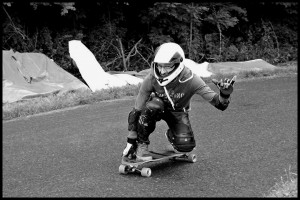
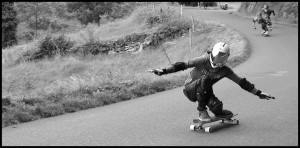
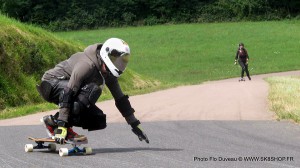
7- Des ambitions pour BadBigBoys Customs Longboards pour l’avenir ? De nouveaux modèles prévus ?
– mon ambition est de continuer à faire les choses simplement, sans péter plus haut que mon cul. Je produis au compte-goutte, des planches artisanales dont une grande partie des phases de travail est manuelle. Pas de machine-outil, beaucoup d’outils qui tiennent dans la main en revanche. J’aime le travail manuel, il impose de rester simple pour devenir meilleur, que ce soit en tenant un crayon ou une râpe. J’ai la tête qui fourmille d’idées, le prochain proto à l’étude, la Bestiale, est une planche tirée des boards de pool, qu’on aurait agrandie pour lui permettre de sortir du bowl et de faire un peu de pente. Elle tapera dans les 85 cm par 24, en double kick, avec un bon tail assez imposant et un nosekick un peu plus petit. Mais c’est pas une freeride-DH non plus… Je crois que je te dirai ce que c’est vraiment quand je l’aurai faite. J’ai aussi envie de taper un deck de dancing, mais je vais être tenté d’y inclure du carbone pour le pop et là, les choses vont se compliquer… J’aime quand même beaucoup l’idée du wood-only.
8- Le mot de la fin. Des remerciements ou des dédicaces ?
– Rouler sans fin !! (dédicace à Momo pour le pitch). Je remercie tous ceux et celles qui me permettent d’évoluer et de grandir au quotidien. Anne, pour l’ensemble de ses encouragements et sa présence, Punkaroulettes et Pierre, pour leur confiance et leur ouverture fasse au nouveau venu que j’étais, Simon, Gaëtan, Camille et Arthur d’Auver’Ride, qui m’ont appris à rouler dans le pentu, ainsi que tous les riders que j’ai pu croiser et qui communiquent notre passion. Je glisse un petit mot de remerciement à Roarockit, sans qui je serai sans doute en train de tenter de fabriquer un bâti de presse, certes efficace, mais tellement plus contraignant, et votre approche amicale à tous les deux, Nico et Sarah. Le mot de la fin va à l’équipe du Cri du Kassis, où j’officie, notamment à Val, sans qui je n’aurai pas la liberté de créer. C’est énorme.
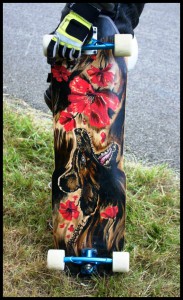
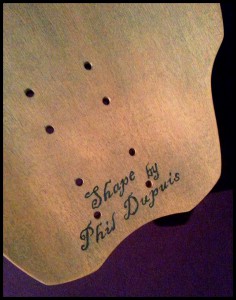
Shape-by-Phil Dupuis
Une série limitée de sa toute dernière planche (La RaceDog), est disponible sur Fulkit.
by Sarah Roarockit | Aug 3, 2014 | News/events
Back in August last year, Roarockit had just started up in Europe and one of our very first customers started with a phone call from the Uk. It was Chris, who was in the process of launching Hurtle skateboards.
Now, several months down the road, we are particularly proud to be able to interview and share the story behind Hurtle skateboards and what it has become today.
Q1: So Chris, tell us a little bit about yourself, where do you come from etc?
Hey! I’m from Exeter in the UK, I’m 24 and I am a skateboard addict. I’m the mind behind Hurtle skateboards, and when I’m not building boards I am usually either working in the local skate shop (Two Seasons in Exeter) or out practicing my cross steps and peterpans. My house is filled with boards, it’s becoming a problem…
Q2: When did you first get into skateboarding?
Later than most people I’ve met – when I was about 17 or 18. I just decided one day out of the blue that I wanted to learn to skate so I dug out my uncle’s old 70’s board (ACS 580s and old Gullwing ‘Wings’ wheels, damn I loved that thing!) and did lengths of the kitchen until I had the balance down. Then I took it to the park rode down the hills. I progressed from there to using a board to commute, then to doing day trips on them, until I found myself sponsored and pushing 1000km around The Netherlands.
A little while after that trip I injured my back and now I can’t push like I used to. Consequently I have dabbled with slalom, and dancing is the current favourite.
Q3: When and why did you start building boards?
That is a story that begins with the death of my uncle’s old board. When I was still fairly new to skating I had a rather spectacular crash whilst going down hill – minor concussion, cracked rib, snapped collar bone, dislocated arm and a healthy smattering of road rash. Worst of all though was the split in my uncle’s board, I was so upset.
I retired it (it’s on my wall now) and bought a longboard. Whilst I waited for my bones to mend I watched a lot of skate videos on youtube and encountered for the first time the concept of chopping a board that is not quite right to make it exactly what you want it to be. This idea stuck with me, and it wasn’t long before I chopped the tail of my longboard and shortened up the wheelbase.
That was the start really. I did numerous chops over the next couple of years, for myself and for friends. I also developed the habit of sanding down and redoing the graphics on my boards which everyone seemed to like. I loved it, tinkering away in my garage like some kind of mad scientist.
The first board I made totally from scratch was actually for my uncle, as a replacement for the one I’d crashed. It was made of cheap builder’s ply, rocker with no concave and made in the most ghetto press you’ve ever seen! I’m talking anvils, logs, bags of sand, many spiders, scraps of metal, bits of brick… anything with decent weight that happened to be to hand at the time went onto the pile to get the rocker on that board.
I carried on chopping, repainting and occasionally ghetto-pressing boards for another 2 years or so, and was getting a lot of praise for them. Just before I started Hurtle Skateboards it got to the point where random people I passed in the street would stop me to ask about my boards, and upon being told that they were home made would tell me I should be making them for a living.
So I’m giving it a swing!
Q4: Where did the name “Hurtle” skateboards come from?
It came from the griptape on one of the custom chops I did just before I started the company. I had cut a little Hawaiian turtle graphic into the tape on the nose and became really attached to the little guy. When I was trying to think of a name and logo I remembered the turtle and thought he would be perfect. Rather than re-draw him I traced the exact turtle straight from the grip tape of that custom board and put it into photoshop (which is why if you look at my logo some of the lines are not quite perfect or of uniform thickness, and that’s the way I like it! Straight from the board!).
So there I was with a logo. From there it was just a case of thinking of a name that would go with it…
Q5: You make your boards with Canadian maple from Roarockit, how did you hear about us and why Canadian maple?
I spent a LONG time trying to source wood for my boards. I knew from the start that I wanted to use Canadian maple – nothing quite feels the same underfoot as a proper maple deck. It’s a strong material, with just the right amount of flex and great pop; it is ideal for building skateboards and it’s not just coincidence that all the big skate companies use it!
As for how I found Roarockit? Google. Google knows all.
Haha I had seen some of the stuff that Roarockit had done over in the states before I started Hurtle, and I remember seeing a dropped pin on Silverfish they had made that I found particularly stunning. It was just good timing that Roarockit EU was starting up at around the same time I was. They had helpful staff (Hi Sarah!) as well as plenty of maple veneer in conveniently skateboard sized pieces. Win/win.
Q6: You have just started up Hurtle Skateboards, how are things going so far?
Pretty well I’d say – going from the initial idea for the company to having boards in the shops in under a year is pretty pleasing! Things are progressing nicely. It’s so fulfilling to see people riding the boards I made and be able to say,
The reactions that my boards seem to get is also hugely encouraging – they are such lovely things to touch and see in person, pictures really can’t do them justice. Once someone has seen and handled one, the boards pretty much sell themselves (which makes my life a lot easier!)
I saw a sign somewhere the other day for a skateboard exhibition that said ‘ride my art’. I thought that was really clever and I’m annoyed I didn’t think of it myself, as that is exactly how I feel about my boards!
Q7: What are you working on now and what are your future projects?
Well I’ve just released the Halfshells, which completes my Origin series. I am planning a slight change to the 2015 Hawksbills but other than that I am really happy with my current 3 decks.
My current priority is getting my website refurbished and working with a Shopping Cart system to make buying my boards online much easier.
Beyond that, prototyping and testing is now underway for the ‘K.T. Series’ so keep an eye out for Hurtle boards with kick tails…
Lastly, I want a proper workshop. That is however currently a bit beyond my budget so I need to sell more boards first!
I do need to find a lady skater for the Hurtle Skate Team, so if you know anybody…
Cheers for the interview!

 So, can you tell us a little bit about yourself, where do you come from, what you did before etc…?
So, can you tell us a little bit about yourself, where do you come from, what you did before etc…?
 What is the spirit of wood’n’stuff? Why did you create it ?
What is the spirit of wood’n’stuff? Why did you create it ?










 “Build Your Own Skateboard” workshop at the Grafisch Lyceum in Rotterdam, Holland. We were more than happy to get him sorted with what was needed and only a little while later we were over the moon, when the first photos of the boards being built in class and then the finished decks were put up on facebook. The result is amazing.
“Build Your Own Skateboard” workshop at the Grafisch Lyceum in Rotterdam, Holland. We were more than happy to get him sorted with what was needed and only a little while later we were over the moon, when the first photos of the boards being built in class and then the finished decks were put up on facebook. The result is amazing. 


































 – La première planche que j’ai sortie, je l’ai offerte à mon fils ainé, qui avait 10 ans alors (mais je la roule également de temps en temps avec un set-up orienté freeride). Puis je me suis pris au jeu, tout en même temps que je progressais un peu dans ma façon de rouler, et que je m’orientais vers le DH. J’ai shapé un deuxième moule qui était censé donner une planche de descente. Le shape était timide, je n’avais pas osé pousser le bois dans ses retranchements et le calage des pieds était vraiment trop light. Je suis reparti avec l’idée de concevoir une board qui me guide tout autant que je la guiderais, et c’est comme ça qu’est née la RaceDog. C’est une board de descente, et non de freeride, elle est faite pour rester au sol, et d’ailleurs elle s’y accroche bien ! En quelques sessions avec, j’ai gagné en confiance et en vitesse, même si je veille à rouler très prudemment. Le contact avec les riders et l’accueil de la board ont fait le reste, je me suis lancé dans la production d’une mini série, le kiff étant de produire pour le plaisir et celui des autres. Pas de vocation mercantile, juste une cohérence entre le but et le travail mis en œuvre.
– La première planche que j’ai sortie, je l’ai offerte à mon fils ainé, qui avait 10 ans alors (mais je la roule également de temps en temps avec un set-up orienté freeride). Puis je me suis pris au jeu, tout en même temps que je progressais un peu dans ma façon de rouler, et que je m’orientais vers le DH. J’ai shapé un deuxième moule qui était censé donner une planche de descente. Le shape était timide, je n’avais pas osé pousser le bois dans ses retranchements et le calage des pieds était vraiment trop light. Je suis reparti avec l’idée de concevoir une board qui me guide tout autant que je la guiderais, et c’est comme ça qu’est née la RaceDog. C’est une board de descente, et non de freeride, elle est faite pour rester au sol, et d’ailleurs elle s’y accroche bien ! En quelques sessions avec, j’ai gagné en confiance et en vitesse, même si je veille à rouler très prudemment. Le contact avec les riders et l’accueil de la board ont fait le reste, je me suis lancé dans la production d’une mini série, le kiff étant de produire pour le plaisir et celui des autres. Pas de vocation mercantile, juste une cohérence entre le but et le travail mis en œuvre.


 moindre repère de découpe ! J’avais dessiné un template (gabarit) pour le contour, évolution de la précédente planche, puis j’ai pris mon temps pour visualiser dans ma tête les zones d’appui, de poussée, d’équilibre, tout en mettant les pieds sur tous les decks que j’ai à la maison et en analysant ce qui me paraissait pertinent , qu’ils soient orientés carving, slalom ou freeride. Je suis parti rouler, je suis rentré, j’ai pris des notes, fait des croquis, reparti rouler et ainsi de suite. J’ai shapé mon moule en tenant compte de l’importance de chaque facteur et mis sous presse par demie-tranche, d’abord les 4 premiers plis, puis dans un second temps les 4 suivants, pour que l’érable épouse les formes du moule au plus près, avec le moins de résistance possible. Quand j’ai démoulé ce premier proto de RaceDog, et que j’ai posé mes pieds nus dessus avant même de l’avoir découpé, j’ai senti que j’avais sorti un truc qui tenait la route. Il y avait l’ensemble des cartactéristiques attendues, sans pour autant avoir un shape violent sous les pieds.
moindre repère de découpe ! J’avais dessiné un template (gabarit) pour le contour, évolution de la précédente planche, puis j’ai pris mon temps pour visualiser dans ma tête les zones d’appui, de poussée, d’équilibre, tout en mettant les pieds sur tous les decks que j’ai à la maison et en analysant ce qui me paraissait pertinent , qu’ils soient orientés carving, slalom ou freeride. Je suis parti rouler, je suis rentré, j’ai pris des notes, fait des croquis, reparti rouler et ainsi de suite. J’ai shapé mon moule en tenant compte de l’importance de chaque facteur et mis sous presse par demie-tranche, d’abord les 4 premiers plis, puis dans un second temps les 4 suivants, pour que l’érable épouse les formes du moule au plus près, avec le moins de résistance possible. Quand j’ai démoulé ce premier proto de RaceDog, et que j’ai posé mes pieds nus dessus avant même de l’avoir découpé, j’ai senti que j’avais sorti un truc qui tenait la route. Il y avait l’ensemble des cartactéristiques attendues, sans pour autant avoir un shape violent sous les pieds.




